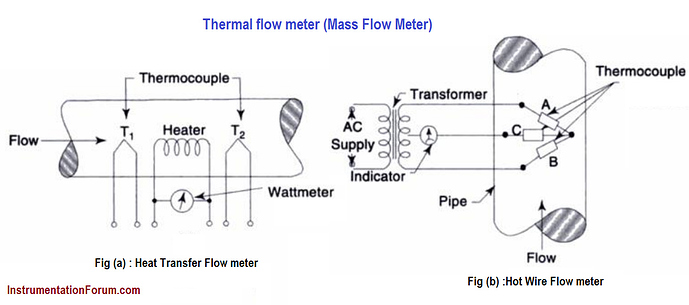Thermal flow meter (Mass Flow Meter) Principle
Principle:
It works on the principle of thermal conductivity.
Construction:
Thermal flowmeters are very popular for the measurement of unsteady flow of gases, and can be used to measure flow rate in terms of mass, which is a very desirable feature, especially on gas service.
There are two types of thermal flowmeters:
- Heat Transfer Flowmeters
- Hot-Wire Flow meters
Heat Transfer Flowmeters
This type of flowmeter measures the rise in the temperature of the fluid after a known amount of heat has been added to it. Its theory is based upon the specific heat equation which is given as,
Q = W Cp (T2 - T1)
Where Q= heat transfer, W= mass flow rate of fluid Cp= Specific heat of the fluid
T1 = initial temperature of fluid after heat has been transferred
T2 = final temperature of fluid after heating the fluid.
CONSTRUCTION AND WORKING
-
A schematic diagram of a heat transfer flowmeter is shown in Fig. (a), which consists of an electric immersion heater for the heating of flowing fluid.
-
Two thermocouples (or resistance thermometers) TI and T2 are placed at each side of the heater as in Fig (a).
-
The thermocouple TI measures the temperature of fluid before it is heated, while the thermocouple T2 measures the temperature so after.
-
The power supply to the heater equals the heat transferred to the fluid, i e. Q, and is measured by a wattmeter. Thus by measuring the values of Q, TI and T2 the flow rate W of liquid is determined from the above equation.
-
This type of flowmeter has disadvantages in that the temperature sensor and the heater are directly placed into the fluid stream, and thus, they are easily damaged by corrosion and erosion.
-
Furthermore, large input power is required to measure high flow rates. These disadvantages are overcome by mounting the heater, and upstream and downstream temperature sensors (TI and T2) on the outside of the piping. But it results in non-linear response.
Hot-Wire Flow meters
-
This type of flowmeter measures the effect of the flowing fluid on a hot body.
-
A hot-wire flowmeter consists of two thermocouples, A and B, connected in series to form a thermopile.
-
A third thermocouple C is placed in the output circuit of the thermopile, as shown in Fig. (b). The thermopile is heated by passing an alternating current to it.
-
The alternating current does not pass through the third thermocouple and it is therefore not electrically heated.
-
The whole assembly is placed into the fluid (usually gas) stream whose flow rate is to be determined. The fluid (gas) cools the heated thermopile by convection, and since the input power to the thermopile is held constant, the thermopile attains an equilibrium temperature and produces an emf that is a function of the temperature of the gas, velocity of the gas, and its density, specific heat, and thermal conductivity.
-
The third thermocouple (unheated) attains the ambient temperature of the gas, generating an emf that is proportional to the gas temperature and which cancels the effect of the ambient gas temperature on the output signal of the heated thermopile.
The output voltage signal of this type of instrument is given by the equation.

Where E= voltage generated, C= instrument constant, K= thermal conductivity of fluid,
Cp= specific heat of fluid, d= diameter of heated thermocouple wire,
V=velocity of fluid and 𝜌 = density of the flowing fluid
It can be designed to work with pressure upto 1200 psig (8.3 MPa).
Advantages:
-
Thermal flow meters have no moving parts, which reduces maintenance and permits the use in demanding application areas, including saturated gas.
-
Gas mass meters calculate mass flow rather than volumetric flow and do not require temperature or pressure correction, which means there is no additional expense for the purchase and installation of additional equipment.
-
Thermal flowmeters provide excellent accuracy and repeatability over a wide range of flow rates.
-
Thermal mass flow meters can measure flow in large pipes.
Disadvantages:
-
Gas mass meter use is limited to clean, non abrasive fluids
-
Presence of moisture or droplets can lead to measurement inaccuracy
-
Thermal properties must be known: variation from calibrated values can cause inaccuracies
-
Relatively high initial cost
